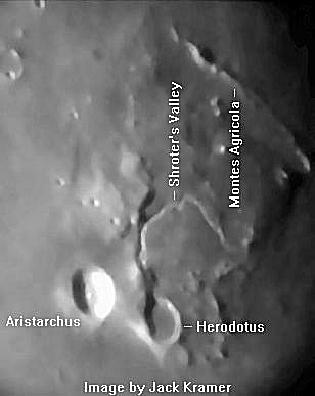Aristarchus & Vallis Schroteri - 12-Day Old Moon
Paul Morow
The Moon Observer's Handbook, by Fred W. Price, states the following on pages 166-167: "Of principal interest is the long and winding cleft, the first of its kind to be discovered (in 1877), named Schroter's Valley after its discoverer, which begins inside Herodotus at the north wall; however, it needs a large telescope and the right lighting to be convinced of this. It starts as a valley which narrows to a fine cleft and this runs into a wide enclosure apparently formed by fusion of two craters. Because of its shape this was named the Cobra-Head by W.H. Steavenson. The valley then narrows and runs for a short distance in a northerly direction, takes a sudden bend to the north-east and continues for several miles before turning south-east and running a similar distance. It then becomes a fine cleft and passes around the south end of a plateau and finishes at a mountain mass. The valley is bright throughout its course and the snake-like twists and bends and the Cobra-Head gives it a striking resemblance to a snake rearing its head in response to the snake charmer's flute!"

Schroter's Valley is the largest sinuous rille on the Moon. It is easily visible through small optical instruments 4 days after First Quarter. Tonight the bright crater Aristarchus and Vallis Schroteri were wonderfully positioned with the terminator following a line just west of Dorsa Burnet. To the north, the tips of Montes Agricola were nicely highlighted with the middle section appearing as two mountain ranges passing each other. The ridge, Dorsum Niggli, was seen forming a bridge between Montes Agricola and the hills to the southeast. Mons Herodotus along with two craterlets NNW were visible as well as craterlet Raman. Craterlet 'N' on the NNW edge of Herodotus was nicely highlighted. Vallis Schroteri was in fine relief with the "Cobra's Head" clearly visible. Within the area formed around Vallis Schroteri the dome NNW of craterlet 'G' was visible as well as one large and two small domes west of it. Many textures in the surface of this area stood out nicely on this night. Vaisala and two craterlets to the east along with craterlet 'Z' to the SSW are also seen. The Rupes Toscanelli were standing out very nicely. SSW of the crater Herodotus, the large craterlet 'A' could be seen also.
Equipment: 155mm f/9 refractor
Reference: Atlas of the Moon, By Antonin Rukl,
Map #18, (Photographs 18 & 19, page 199)
Published in the July 2003 issue of the NightTimes




